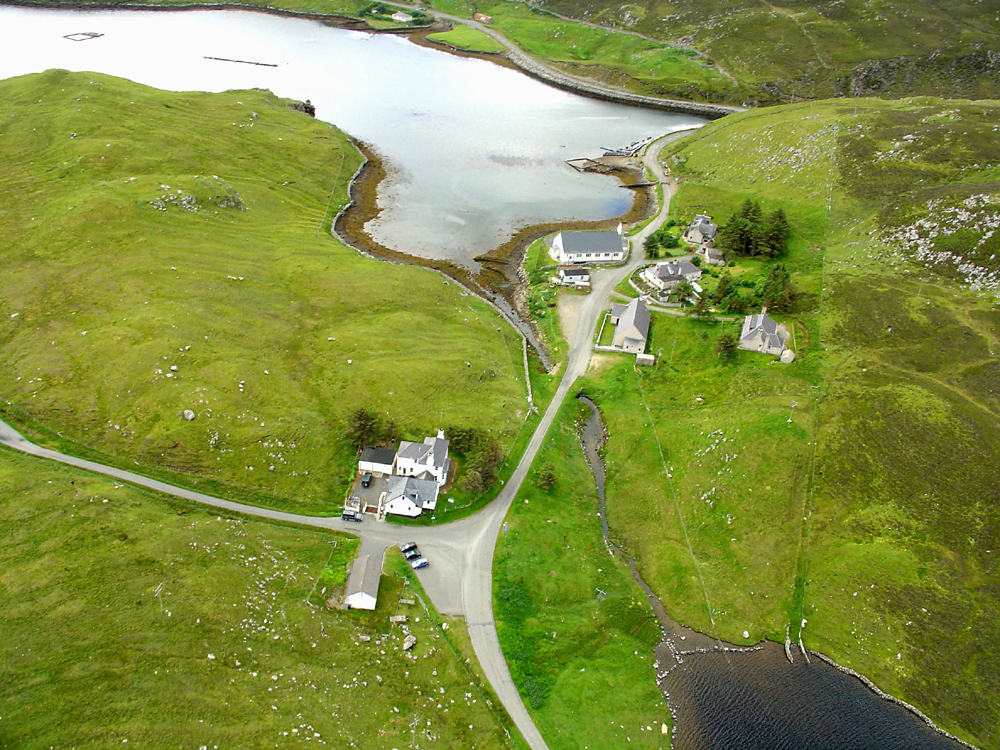Miavaig, Carishader and the Bays in 1959
A chapter (abridged) by Annis Heawood from Uig: A Hebridean Parish (1960). Photo by Chris Murray.
The district here described includes Gisla, near the head of Little Loch Roag, Enaclete, Ungeshader and Geshader, on the western shores of Loch Roag proper. All these are strung out on or close to the main road. Miavaig, like Gisla, is a small farm but also functions as something of a metropolis for south Uig; it has the post master, whose other functions include registrar and receiver of wrecks, and it has two churches, a telephone exchange, the district doctor and mans, and a petrol pump. At the time of our visit it was also the base for the ‘bus service. Its metropolitan functions arose in the days before the road replaced a ferry boat service from Callanish; here the mails were landed until some date in the 1920s and here to the estate kept coach and horses for transport to Uig Lodge, three miles further west.
There is no record of the original settlement of the four crofting townships, nor of Gisla, which was a township or joint farm of five crofters until about 1850. Some modern houses and bungalows have been built, many with easier access to the road than the old black houses, now often used as byres. Water supply does not seem to present a serious problem because of the extensive moorland gathering grounds to the west, but there are not at present any water-supply schemes. Electricity is, of course, available. Carishader an Enaclete are on the main Stornoway road being served at present by the ‘bus and by vans selling meat, groceries and fish at least once a week. Enaclete has a sub-postoffice. Geshader is less fortunate since, although vans call regularly, ‘buses must be met at the junction of the unsurfaced track and the main Stornoway road, where the school serving this district also stands. The track has been extended in recent years so that it now reaches all the houses. Ungeshader, however , is smaller and although it has had similar delivery arrangements, it is now a dying settlement largely due to its inaccessibility.
The rhythm of work is similar to that in other parts of western Uig. Potatoes and oats are planted in April followed by lambing and peat cutting in May. In June and July the sheep are shorn and subsequently sent to the common grazings. In August the peat are carted, once they are dry, by lorry direct to the crofts. Haymaking follows. The lambs are weaned in September, harvest is then carried in and tupping and statutory dipping take place in November. The sheep are then returned to the township grazing though the lambs may be fed with hay on the croft. There is little regular crop rotation and only a small number of crofters seem to undersow oats, thus improving the quality of future hay crops. Gardens are not important and only provide for family needs but Carishader particularly has a number, some growing flowers as well as vegetables. Fertilisers vary widely from croft to croft as well as township to township. Enaclete potatoes are still grown near the shore and thrive on seaweed; those of Carishader are usually fed on artificials.
Most crofters keep one milk cow with a calf; a few rear a young beast for the autumn sales in Carishader. however, some now rely on their neighbours for milk in return for grazing and one croft has turned to goats, as giving less trouble. The bull for the whole district is a beef shorthorn and is kept on Geshader-Ungeshader common grazing as it is completely fenced; and Geshader is responsible for its upkeep.
The shielings have been disused since the war. Peat is normally cut to the west of the road but at least one elderly tenant in Geshader has kept a section of his croft for this purpose to save the effort of working further afield.
Generally speaking the land now cropped only represents one third to one half of that worked by spade 20-50 years ago when the crofting population was larger and when much greater numbers of cattle were kept through the winter, thus requiring more potatoes and more oats. The cattle numbers are much less than the total souming but sheep are in excess. In Enaclete, at least, overgrazing by sheep has caused a decline in grazing quality.
Clearly in these townships, apart from the very few crofts still fully cultivated, the means of livelihood is sought elsewhere. At present there are altogether fifty-three men in the working age group in all four townships. OF these fourteen are away, nine permanently and five periodically. Thirty have regular or periodic employment besides crofting and of these seven work at Gisla on the hydro-electric scheme, seven weave, some of them part-time, four hire out vans, two do post office work and others have varied occupations while there are only three full-time crofters. At present there are a few men in the Merchant Navy and fishing does not provide an occupation although many share rowing boats in their spare time, and fish for domestic use. It is noticeable that there are few crofts worked by young families.


